Focal Mechanism and Source Parameters Analysis of Mining-Induced Earthquakes Based on Relative Moment Tensor Inversion
Abstract
:1. Introduction
2. Inversion Method of the Relative Moment Tensor for the Focal Mechanism of Mining-Induced Earthquakes
2.1. Purpose of Focal Mechanism Inversion via MTI
2.2. Application and Optimization of Relative Moment Tensor Inversion Method in Underground Coal Mines
3. Focal Mechanism Solution of MIEs
3.1. Solution of Source Rupture Occurrence
3.2. Identification of Source Rupture Type
- There is a positive correlation between the MDC % and , which means that the two indexes are consistent in identifying the source rupture type, but both need a reasonable range of identification.
- There is a nonlinear correlation between them, indicating that the shear displacement is still dominant when the MDC % is relatively low (MDC % ∈ [20,40]). It reminds us that there may be a bias on those sources characterizing low MDC % but high shear displacement.
- Due to the nonlinear relationship between MDC % and the specific interval of both MDC % and should change with .

3.3. Guidelines on the Implementation
4. Response Laws of Focal Mechanism and Source Parameters (RLFMSPs) in Frequent Rock Burst Area
4.1. A Case of RLFMSPs in Fold Structure Area
4.2. A Case of RLFMSPs in Deep Buried Fault Area
4.3. A Case of RLFMSPs in High-Stress Roadway Pillar Area
5. Conclusions
- In the typical fold structure area, the tensile-type sources are located in the roof and coal seam, while the shear types are primarily located near the coal seam. In addition, there is a close relationship between the occurrence of the rupture surface and the source elevation. The difference in source rupture strength and stress adjustment between tensile types and shear types is negligible, while the disturbance scale of tensile types is distinct.
- In the deep buried fault area, the rupture of sources in the roof and coal are dominant tensile and shear types, respectively. The tensile types have higher source energy but lower seismic moment than shear types. The apparent volume of shear types is about three times for tensile types. The apparent stress of the tensile types is higher than that of the shear types, representing that the stress concentration still exists in the roof after the MIEs, but the stress near the faults could be effectively released.
- In the high-stress roadway pillar area, the primary fracture of coal pillars easily produces continuous shear ruptures along the dominant stress direction under the extrusion of roofs and floors, which leads to a dominated shear-type rupture. The source parameters (except apparent stress) of shear types are higher than that of tensile types and show a higher dynamic risk.
Author Contributions
Funding
Informed Consent Statement
Data Availability Statement
Conflicts of Interest
Appendix A
Inversion Matrix Construction of the Relative MTI Method
Appendix B
Inversion Matrix Solution of the Relative Method
- (1)
- Calculation of Ray and Source Number Conditions
- (2)
- Inversion matrix solution method
Appendix C
| Source Parameters | Parameter Meaning | Formula for the Calculation | Parameter Information |
|---|---|---|---|
| Corner frequency | Preliminarily judge the size of the mining-induced earthquake scale; the larger the scale, the richer the low-frequency components of the spectrum. | The frequency corresponding to the intersection of the progressive high frequency trend and low frequency level of the source amplitude spectrum in logarithmic coordinates. | = medium density in source area; = wave velocity in source area; = the distance between source and station; = level of spectrum at low frequencies; = radiation pattern (P-waves = 0.52, S-waves = 0.63); = constant for the Brune model (2.34); = corner frequency; = shear modulus in source area; = seismic radiated energy. |
| Scalar seismic moment | Describe the source intensity defined by the source couple model. | ||
| Source radius | Characterize the influence range of source rupture. | ||
| Apparent volume | Characterize the volume of inelastic deformation of the source. | ||
| Stress drop | Characterize the level of stress reduction before and after an earthquake. | ||
| Apparent stress | Characterize the stress level at the source after the occurrence of an earthquake. |
References
- Cai, W.; Dou, L.; Si, G.Y.; Cao, A.; He, J.; Liu, S. A principal component analysis/fuzzy comprehensive evaluation model for coal burst liability assessment. Int. J. Rock Mech. Min. Sci. 2016, 81, 62–69. [Google Scholar] [CrossRef]
- Larsson, K. Seismicity in Mines A Review; Luleå University of Technology: Luleå, Sweden, 2004. [Google Scholar]
- Cao, A.; Liu, Y.; Jiang, S.; Hao, Q.; Peng, Y.; Bai, X.; Yang, X. Numerical Investigation on Influence of Two Combined Faults and Its Structure Features on Rock Burst Mechanism. Minerals 2021, 11, 1438. [Google Scholar] [CrossRef]
- Akdag, S.; Karakus, M.; Nguyen, G.D.; Taheri, A.; Bruning, T. Evaluation of the propensity of strain burst in brittle granite based on post-peak energy analysis. Undergr. Space 2021, 6, 1–11. [Google Scholar] [CrossRef]
- Cao, A.; Dou, L.; Cai, W.; Gong, S.; Liu, S.; Jing, G. Case study of seismic hazard assessment in underground coal mining using passive tomography. Int. J. Rock Mech. Min. Sci. 2015, 78, 1–9. [Google Scholar] [CrossRef]
- Faradonbeh, R.S.; Taheri, A.; Karakus, M. The propensity of the over-stressed rock masses to different failure mechanisms based on a hybrid probabilistic approach. Tunn. Undergr. Space Technol. 2022, 119, 104214. [Google Scholar] [CrossRef]
- Khan, M.; He, X.; Farid, A.; Song, D.; Li, Z.; Tian, X.; Ni, M. A novel geophysical method for fractures mapping and risk zones identification in a coalmine, Northeast, China. Energy Rep. 2021, 7, 3785–3804. [Google Scholar] [CrossRef]
- Vardar, O.; Zhang, C.; Canbulat, I.; Hebblewhite, B. Numerical modelling of strength and energy release characteristics of pillar-scale coal mass. J. Rock Mech. Geotech. Eng. 2019, 11, 935–943. [Google Scholar] [CrossRef]
- Feng, J.; Wang, E.; Ding, H.; Huang, Q.; Chen, X. Deterministic seismic hazard assessment of coal fractures in underground coal mine: A case study. Soil Dyn. Earthq. Eng. 2020, 129, 105921. [Google Scholar] [CrossRef]
- Ortlepp, W. RaSiM Comes of Age—A Review of the Contribution to the Understanding and Control of Mine Rockbursts. In Proceedings of the 6th International Symposium on Rockbursts and Seismicity in Mines, Perth, Australia, 9–11 March 2005. [Google Scholar]
- Li, D.; Zhang, J.; Sun, Y.; Li, G. Evaluation of Rockburst Hazard in Deep Coalmines with Large Protective Island Coal Pillars. Nat. Resour. Res. 2021, 30, 1835–1847. [Google Scholar] [CrossRef]
- CGTN. Cause of Rock Burst in NE China under Investigation. Available online: https://news.cgtn.com/news/3d3d514f35456a4d35457a6333566d54/index.html (accessed on 7 October 2021).
- Cai, W.; Dou, L.; Zhang, M.; Cao, W.; Shi, J.; Feng, L. A fuzzy comprehensive evaluation methodology for rock burst forecasting using microseismic monitoring. Tunn. Undergr. Space Technol. 2018, 80, 232–245. [Google Scholar] [CrossRef]
- Xue, C.; Cao, A.; Guo, W.; Wang, S.; Liu, Y.; Shen, Z. Mechanism of Coal Burst and Prevention Practice in Deep Asymmetric Isolated Coal Pillar: A Case Study from YaoQiao Coal Mine. Shock. Vib. 2021, 2021, 3751146. [Google Scholar] [CrossRef]
- Cai, W.; Dou, L.; Si, G.; Hu, Y. Fault-induced coal burst mechanism under mining-induced static and dynamic stresses. Engineering 2021, 7, 687–700. [Google Scholar] [CrossRef]
- Lu, J.; Zhang, D.; Huang, G.; Li, X.; Gao, H.; Yin, G. Effects of loading rate on the compound dynamic disaster in deep underground coal mine under true triaxial stress. Int. J. Rock Mech. Min. Sci. 2020, 134, 104453. [Google Scholar] [CrossRef]
- Manouchehrian, A.; Cai, M. Numerical modeling of rockburst near fault zones in deep tunnels. Tunn. Undergr. Space Technol. 2018, 80, 164–180. [Google Scholar] [CrossRef]
- Wei, C.; Zhang, C.; Canbulat, I.; Huang, W. Numerical investigation into impacts of major fault on coal burst in longwall mining—A case study. Int. J. Rock Mech. Min. Sci. 2021, 147, 104907. [Google Scholar] [CrossRef]
- Meng, F.; Zhou, H.; Wang, Z.; Zhang, L.; Kong, L.; Li, S.; Zhang, C. Experimental study on the prediction of rockburst hazards induced by dynamic structural plane shearing in deeply buried hard rock tunnels. Int. J. Rock Mech. Min. Sci. 2016, 86, 210–223. [Google Scholar] [CrossRef]
- Zhu, G.; Dou, L.; Wang, C.; Ding, Z.; Feng, Z.; Xue, F. Experimental study of rock burst in coal samples under overstress and true-triaxial unloading through passive velocity tomography. Saf. Sci. 2019, 117, 388–403. [Google Scholar] [CrossRef]
- Stewart, R.A.; Reimold, W.U.; Charlesworth, E.G.; Ortlepp, W.D. The nature of a deformation zone and fault rock related to a recent rockburst at Western Deep Levels Gold Mine, Witwatersrand Basin, South Africa. Tectonophysics 2001, 337, 173–190. [Google Scholar] [CrossRef]
- Uskov, V.A.; Eremenko, A.A.; Darbinyan, T.P.; Marysyuk, V.P. Geodynamic Hazard Assessment for Tectonic Structures in Underground Mining of North Ore Bodies in the Oktyabrsky Deposit. J. Min. Sci. 2019, 55, 77–87. [Google Scholar] [CrossRef]
- Keneti, A.; Sainsbury, B.; Dargaville, R. Consideration of Strain-Bursting Phenomena Associated with Large-Scale Discontinuities: A Numerical Study. Pure Appl. Geophys. 2021, 178, 3581–3600. [Google Scholar] [CrossRef]
- Sainoki, A.; Schwartzkopff, A.K.; Jiang, L.; Mitri, H.S. Numerical Modeling of Complex Stress State in a Fault Damage Zone and Its Implication on Near-Fault Seismic Activity. J. Geophys. Res. Solid Earth 2021, 126, e2021JB021784. [Google Scholar] [CrossRef]
- Wang, C.; Si, G.; Zhang, C.; Cao, A.; Canbulat, I. A Statistical Method to Assess the Data Integrity and Reliability of Seismic Monitoring Systems in Underground Mines. Rock Mech. Rock Eng. 2021, 54, 5885–5901. [Google Scholar] [CrossRef]
- Cao, W.; Shi, J.; Si, G.; Durucan, S.; Korre, A. Numerical modelling of microseismicity associated with longwall coal mining. Int. J. Coal Geol. 2018, 193, 30–45. [Google Scholar] [CrossRef]
- Si, G.; Cai, W.; Wang, S.; Li, X. Prediction of Relatively High-Energy Seismic Events Using Spatial–Temporal Parametrisation of Mining-Induced Seismicity. Rock Mech. Rock Eng. 2020, 53, 5111–5132. [Google Scholar] [CrossRef]
- Urbancic, T.I.; Trifu, C.I.; Long, J.M.; Young, R.P. Space-time correlations of b values with stress release. Pure Appl. Geophys. Pageoph 1992, 139, 449–462. [Google Scholar] [CrossRef]
- Glazer, S.N. Mine Seismology: Seismic Warning Concept; Springer International Publishing: Berlin/Heidelberg, Germany, 2018. [Google Scholar]
- Chen, F.; Cao, A.; Liang, Z.; Liu, Y. A Coal Burst Risk Assessment Model of Seismic Events Based on Multiple Seismic Source Parameters: A Case Study of the Huating Coal Mine, Gansu Province, China. Nat. Resour. Res. 2021, 30, 4515–4532. [Google Scholar] [CrossRef]
- Gibowicz, S.J.; Lasocki, S. Seismicity induced by mining: Ten years later. In Advances in Geophysics; Dmowska, R., Saltzman, B., Eds.; Elsevier: Amsterdam, The Netherlands, 2001; Volume 44, pp. 39–181. [Google Scholar]
- Gibowicz, S.J. Chapter 1—Seismicity Induced by Mining: Recent Research. In Advances in Geophysics; Elsevier: Amsterdam, The Netherlands, 2009; Volume 51, pp. 1–53. [Google Scholar]
- Ortlepp, W. Rock Fracture and Rockbursts: An Illustrative Study; South African Institute of Mining and Metallurgy: Perth, Australia, 1997. [Google Scholar]
- Zhang, W.; Ma, N.; Ren, J.; Li, C. Peak particle velocity of vibration events in underground coal mine and their caused stress increment. Measurement 2021, 169, 108520. [Google Scholar] [CrossRef]
- Ma, K.; Yuan, F.; Wang, H.; Zhang, Z.; Sun, X.; Peng, Y.; Wang, H. Fracture mechanism of roof key strata in Dongjiahe coal mine using microseismic moment tensor. Geomat. Nat. Hazards Risk 2021, 12, 1467–1487. [Google Scholar] [CrossRef]
- Vavrycuk, V.; Kühn, D. Moment tensor inversion of waveforms: A two-step time-frequency approach. Geophys. J. Int. 2012, 190, 1761. [Google Scholar] [CrossRef] [Green Version]
- Nakamura, M. Determination of focal mechanism solution using initial motion polarity of P and S waves. Phys. Earth Planet. Inter. 2002, 130, 17–29. [Google Scholar] [CrossRef]
- Jechumtálová, Z.; Šílený, J. Amplitude ratios for complete moment tensor retrieval. Geophys. Res. Lett. 2005, 32. [Google Scholar] [CrossRef]
- Li, J.; Zhang, H.; Kuleli, H.; Toksoz, M. Focal Mechanism Determination Using High Frequency Waveform Matching and Its Application to Small Magnitude Induced Earthquakes. Geophys. J. Int. 2011, 184, 1261–1274. [Google Scholar] [CrossRef] [Green Version]
- Ma, J.; Dineva, S.; Cesca, S.; Heimann, S. Moment tensor inversion with three-dimensional sensor configuration of mining induced seismicity (Kiruna mine, Sweden). Geophys. J. Int. 2018, 213, 2147–2160. [Google Scholar] [CrossRef]
- Aki, K.; Richards, P. Quantitative Seismology Theory; W.H. Freeman: San Francisco, CA, USA, 2002; Volume 1. [Google Scholar]
- Gilbert, F. Excitation of the Normal Modes of the Earth by Earthquake Sources. Geophys. J. Int. 1971, 22, 223–226. [Google Scholar] [CrossRef] [Green Version]
- Shearer, P. Introduction to Seismology; Cambridge University Press: London, UK, 2019. [Google Scholar]
- Gibowicz, S.J.; Kijko, A. An Introduction to Mining Seismology; Academic Press: London, UK, 1994. [Google Scholar]
- Chen, F. Failure Mechanism of Mining Induced Tremor and Response Law of Its Source Mechanics Parameters; China University of Mining & Technology: Xuzhou, China, 2019. [Google Scholar]
- Urbancic, T.I.; Trifu, C.I.; Mercer, R.; Feustel, A.J.; Alexander, J.A.G. Automatic time-domain calculation of source parameters for the analysis of induced seismicity. Bull. Seismol. Soc. Am. 1996, 86, 1627–1633. [Google Scholar]
- Cao, A. Research on Seismic Effort of Burst and Failure of Coal Rock Mass Associated with Mining and Its Application; China University of Mining and Technology: Xuzhou, China, 2009. [Google Scholar]
- Linzer, L. A Relative Moment Tensor Inversion Technique Applied to Seismicity Induced by Mining. Rock Mech. Rock Eng. 2005, 38, 81–104. [Google Scholar] [CrossRef]
- Oncescu, M.C. Relative seismic moment tensor determination for Vrancea intermediate depth earthquakes. Pure Appl. Geophys. 1986, 124, 931–940. [Google Scholar] [CrossRef]
- Patton, H. Reference point equalization method for determining the source and path effects of surface waves. J. Geophys. Res. Solid Earth 1980, 85, 821–848. [Google Scholar] [CrossRef] [Green Version]
- Strelitz, R.A. The fate of the downgoing slab: A study of the moment tensors from body waves of complex deep-focus earthquakes. Phys. Earth Planet. Inter. 1980, 21, 83–96. [Google Scholar] [CrossRef]
- Dahm, T. Relative moment tensor inversion based on ray theory: Theory and synthetic tests. Geophys. J. Int. 2007, 124, 245–257. [Google Scholar] [CrossRef] [Green Version]
- Šílený, J.; Milev, A. Source Mechanism of Mining Induced Seismic Events—Resolution of Double Couple and Non Double Couple Models. AGU Fall Meet. Abstr. 2006, 7. [Google Scholar] [CrossRef]
- Baig, A.; Urbancic, T. Microseismic moment tensors: A path to understanding frac growth. Lead. Edge 2010, 29, 320–324. [Google Scholar] [CrossRef]
- Herrmann, R.; Malagnini, L.; Munafò, I. Regional Moment Tensors of the 2009 L’Aquila Earthquake Sequence. Bull. Seismol. Soc. Am. 2011, 101, 975–993. [Google Scholar] [CrossRef]
- Dubinski, J.; Stec, K.; Bukowska, M. Geomechanical and Tectonophysical Conditions of Mining-Induced Seismicity in the Upper Silesian Coal Basin in Poland: A Case Study. Arch. Min. Sci. 2019, 64, 163–180. [Google Scholar] [CrossRef]
- Ma, K.; Sun, X.; Tang, C.; Wang, S.; Yuan, F.; Peng, Y.; Liu, K. An early warning method for water inrush in Dongjiahe coal mine based on microseismic moment tensor. J. Cent. South Univ. 2020, 27, 3133–3148. [Google Scholar] [CrossRef]
- Kaveh, A. Particle swarm optimization. In Advances in Metaheuristic Algorithms for Optimal Design of Structures; Springer: Berlin, Germany, 2021; pp. 13–46. [Google Scholar]
- Li, H.; Yao, Z. Microseismic focal mechanism inversion in frequency domain based on general dislocation point model. Chin. J. Geopgysics 2018, 61, 905–916. [Google Scholar]
- Ohtsu, M. Acoustic emission theory for moment tensor analysis. Res. Nondestruct. Eval. 1995, 6, 169–184. [Google Scholar] [CrossRef]
- Vavrycuk, V. Inversion for parameters of tensile earhquakes. J. Geophys. Res. Solid Earth 2001, 106, 16339–16355. [Google Scholar] [CrossRef]
- Horner, R.; Hasegawa, H. The seismotectonics of southern Saskatchewan. Can. J. Earth Sci. 2011, 15, 1341–1355. [Google Scholar] [CrossRef]
- Ghosh, G.; Sivakumar, C. Application of underground microseismic monitoring for ground failure and secure longwall coal mining operation: A case study in an Indian mine. J. Appl. Geophys. 2018, 150, 21–39. [Google Scholar] [CrossRef]
- Partlett, B.; Crandall, S. The Symmetric Eigenvalue Problem. J. Appl. Mech. 1981, 48, 988. [Google Scholar] [CrossRef]
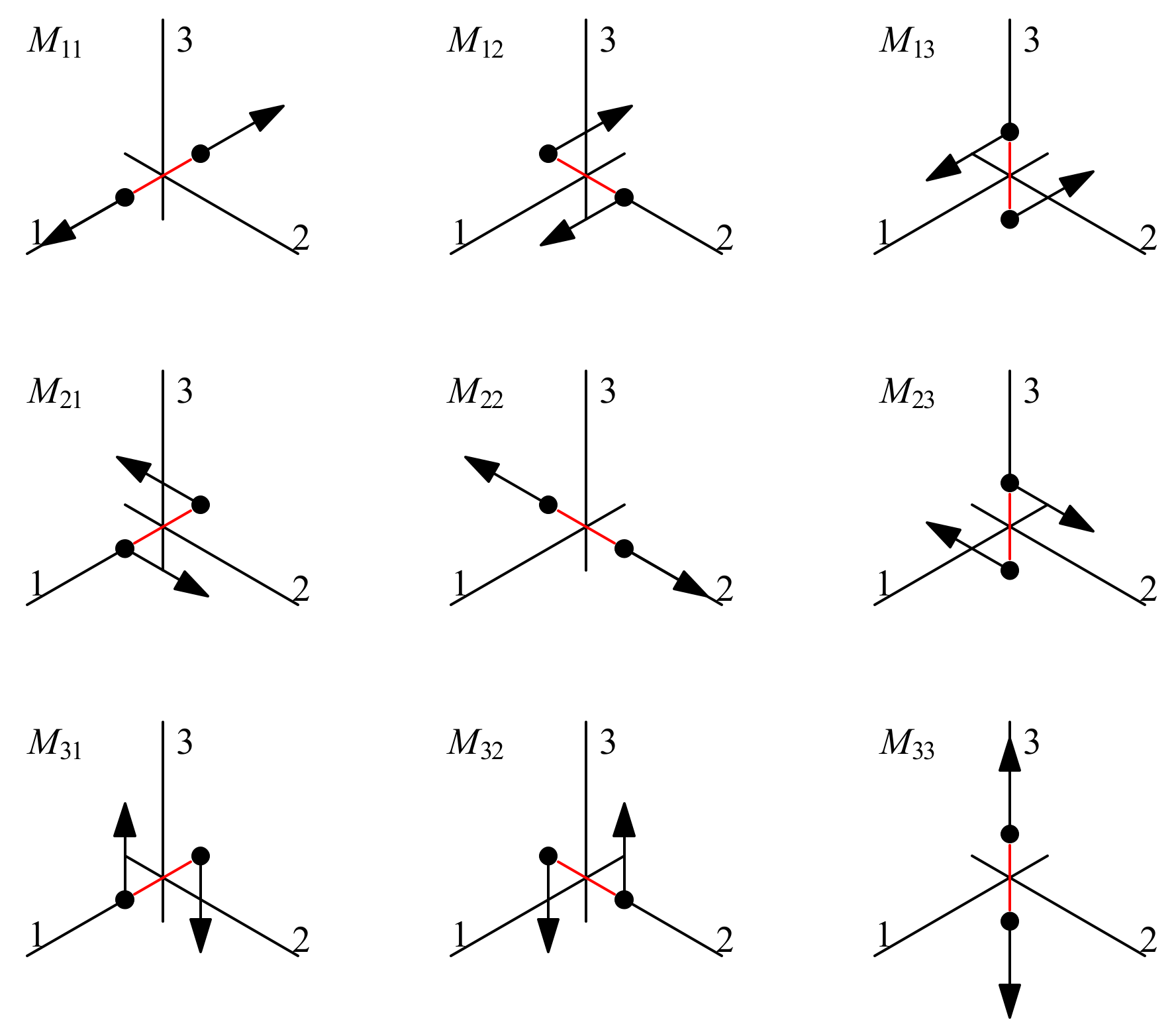

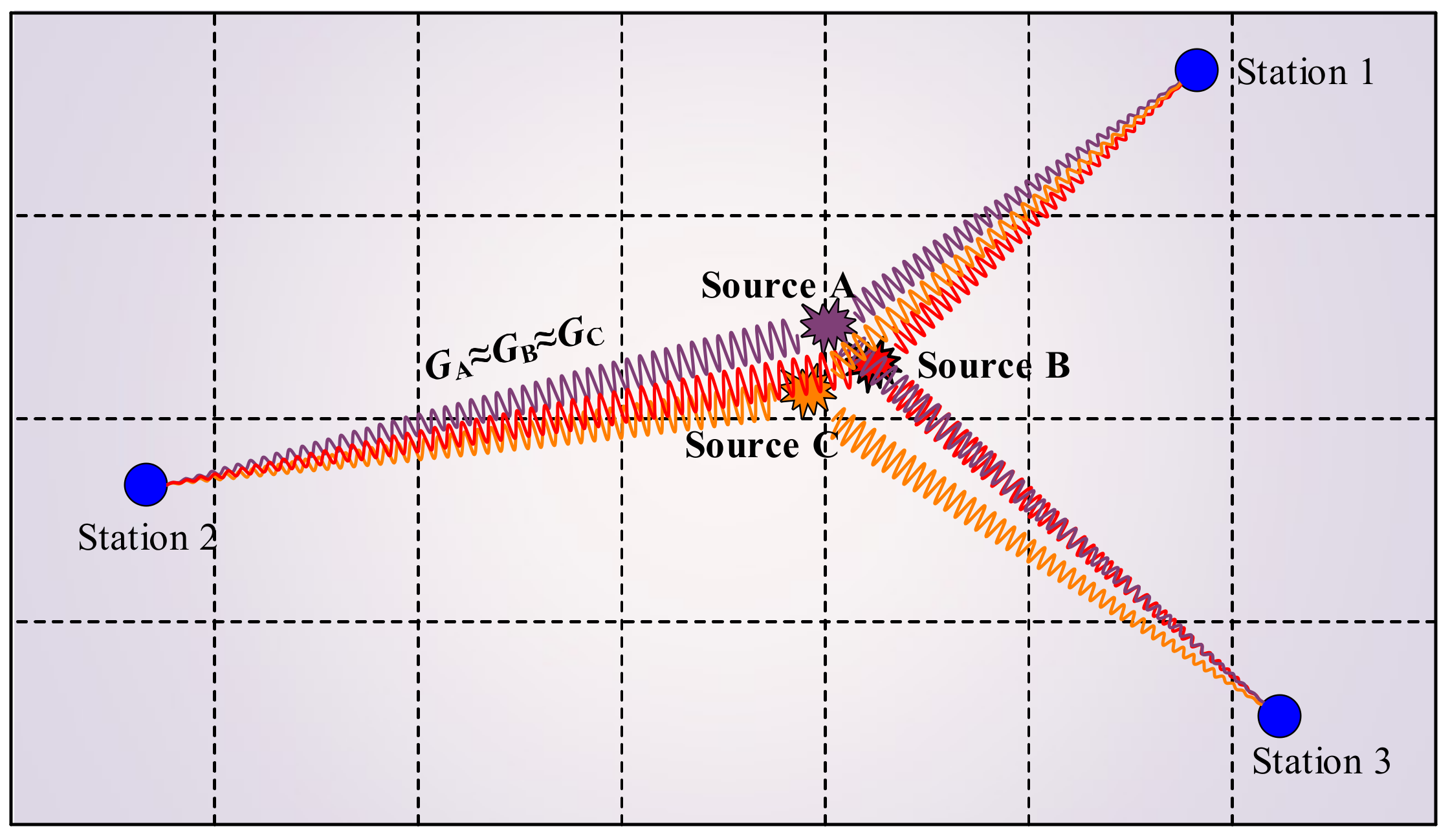
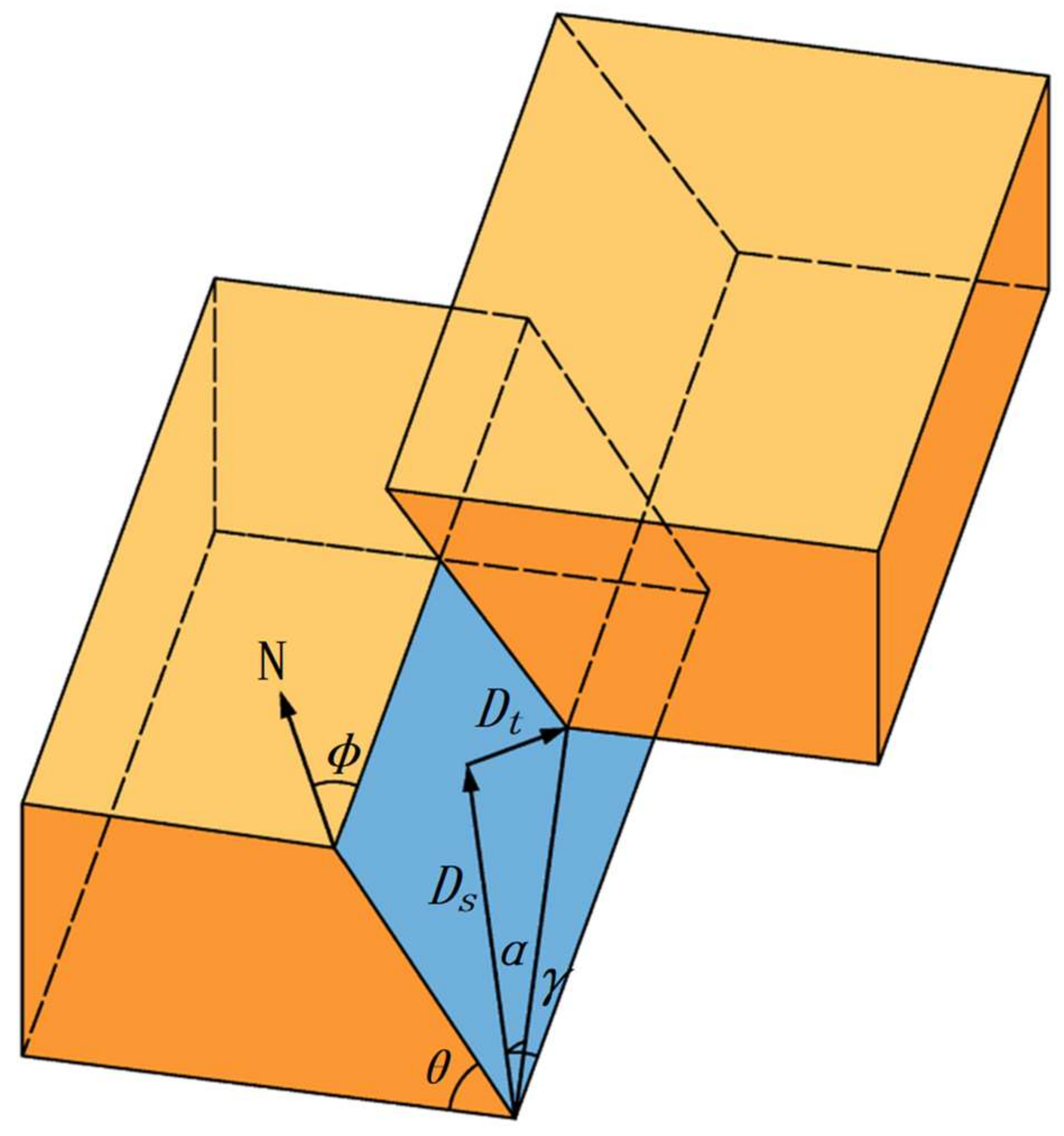
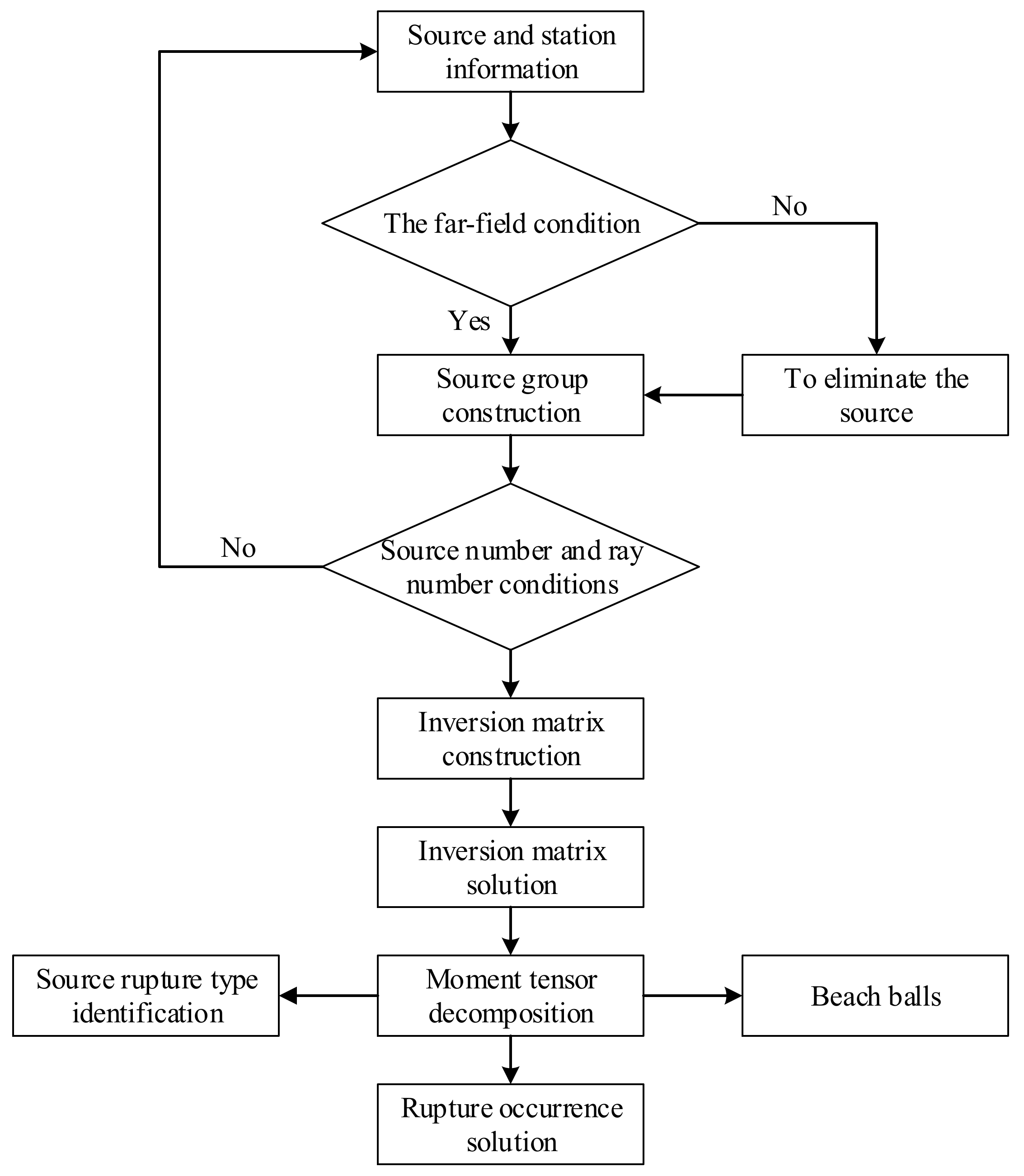
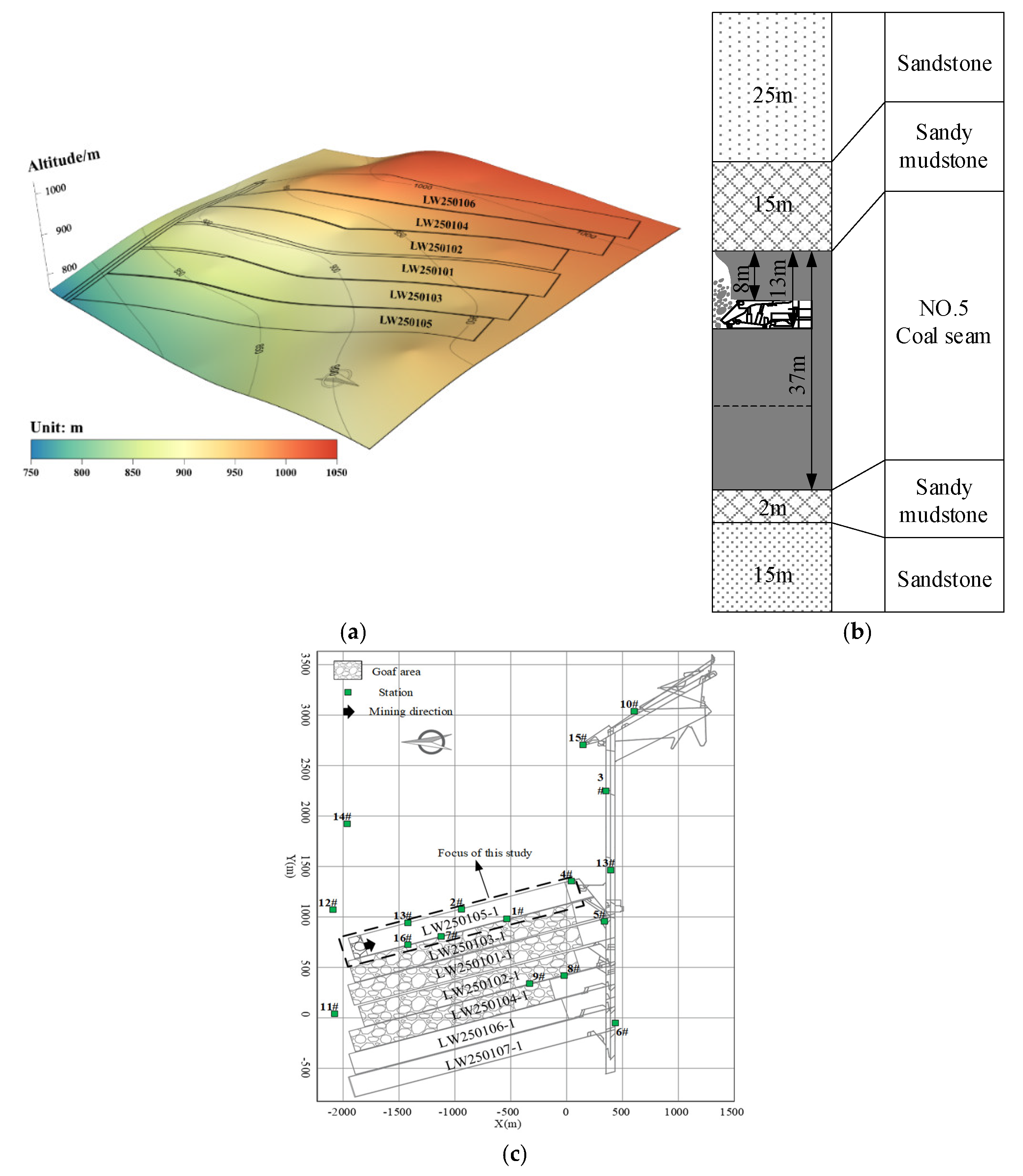
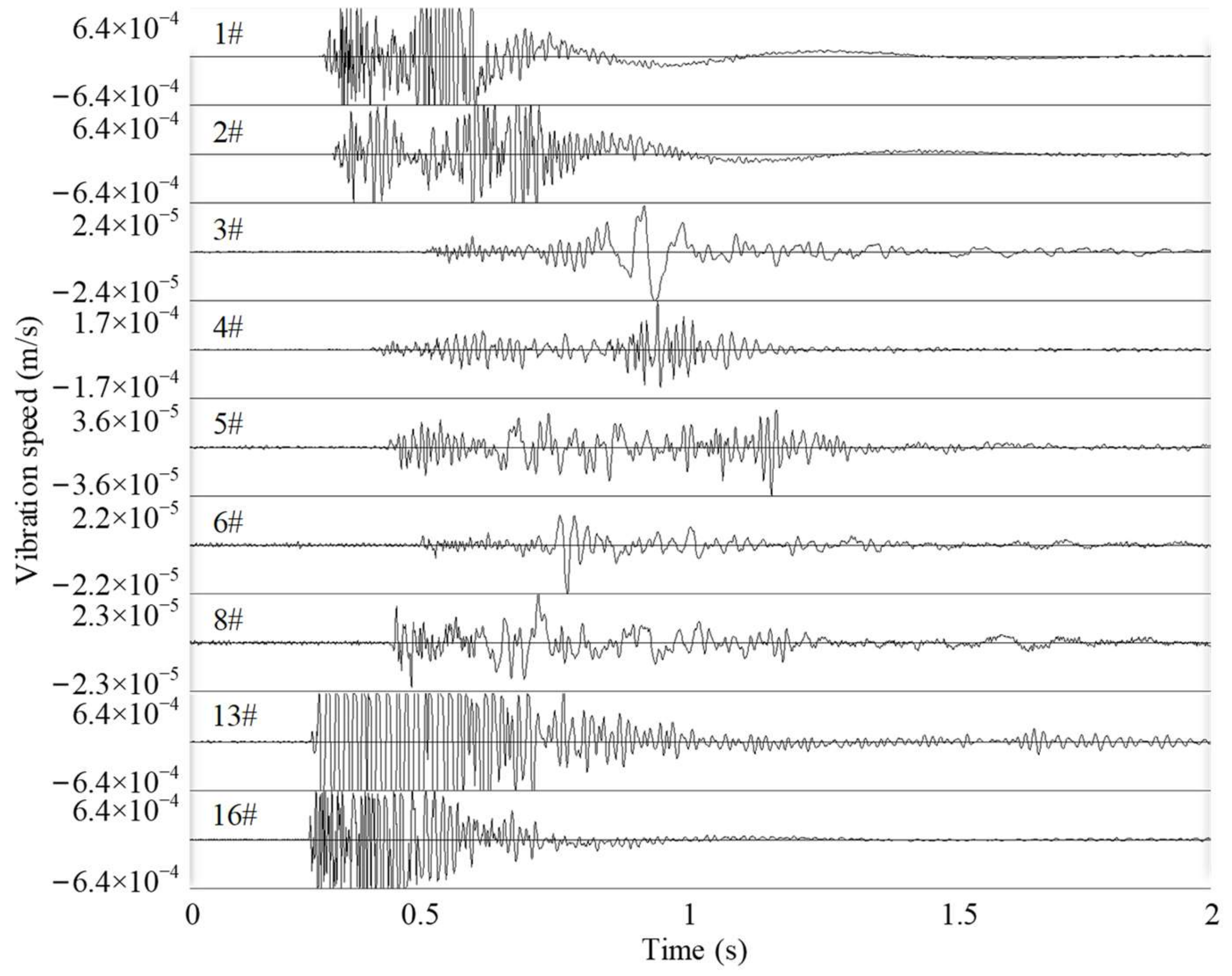
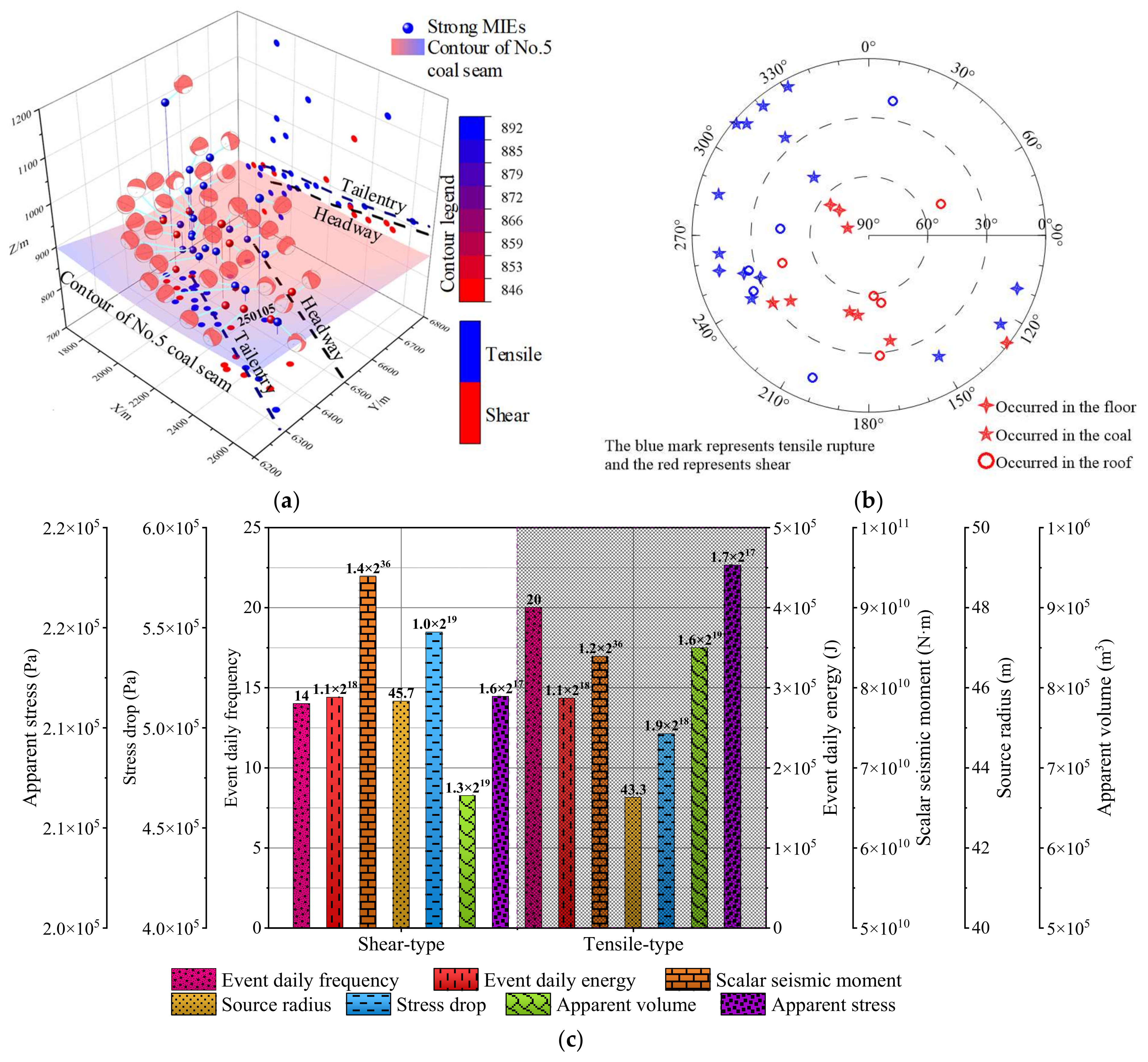

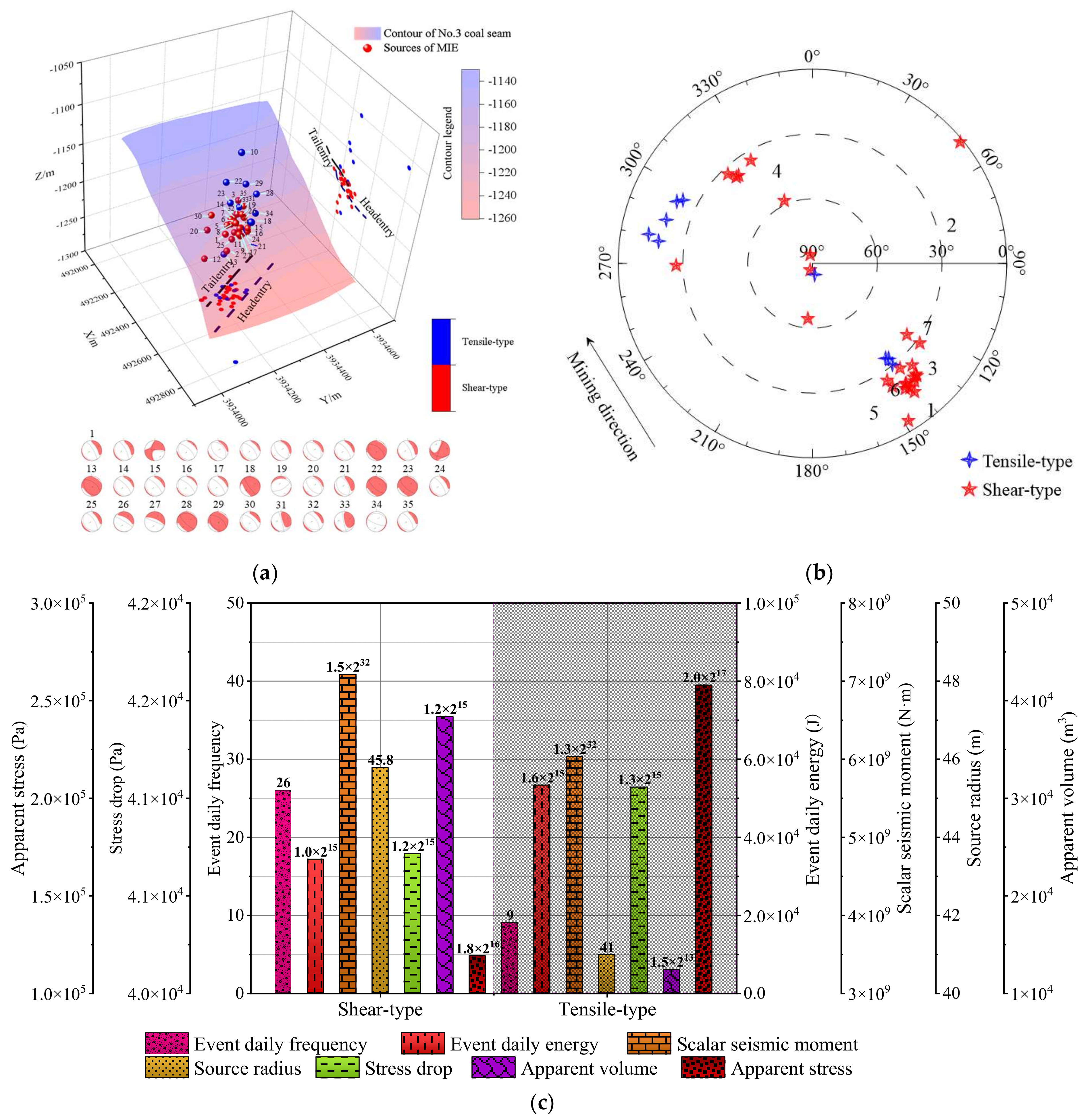
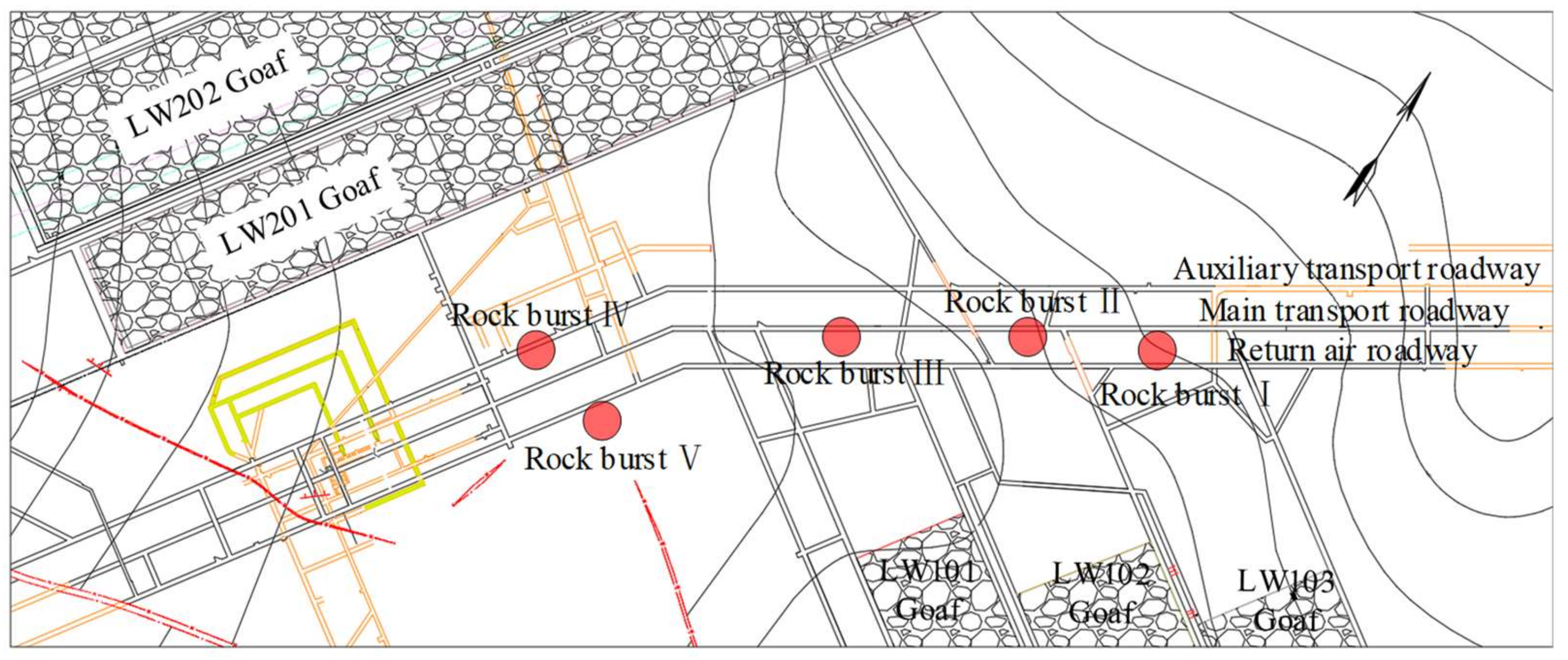
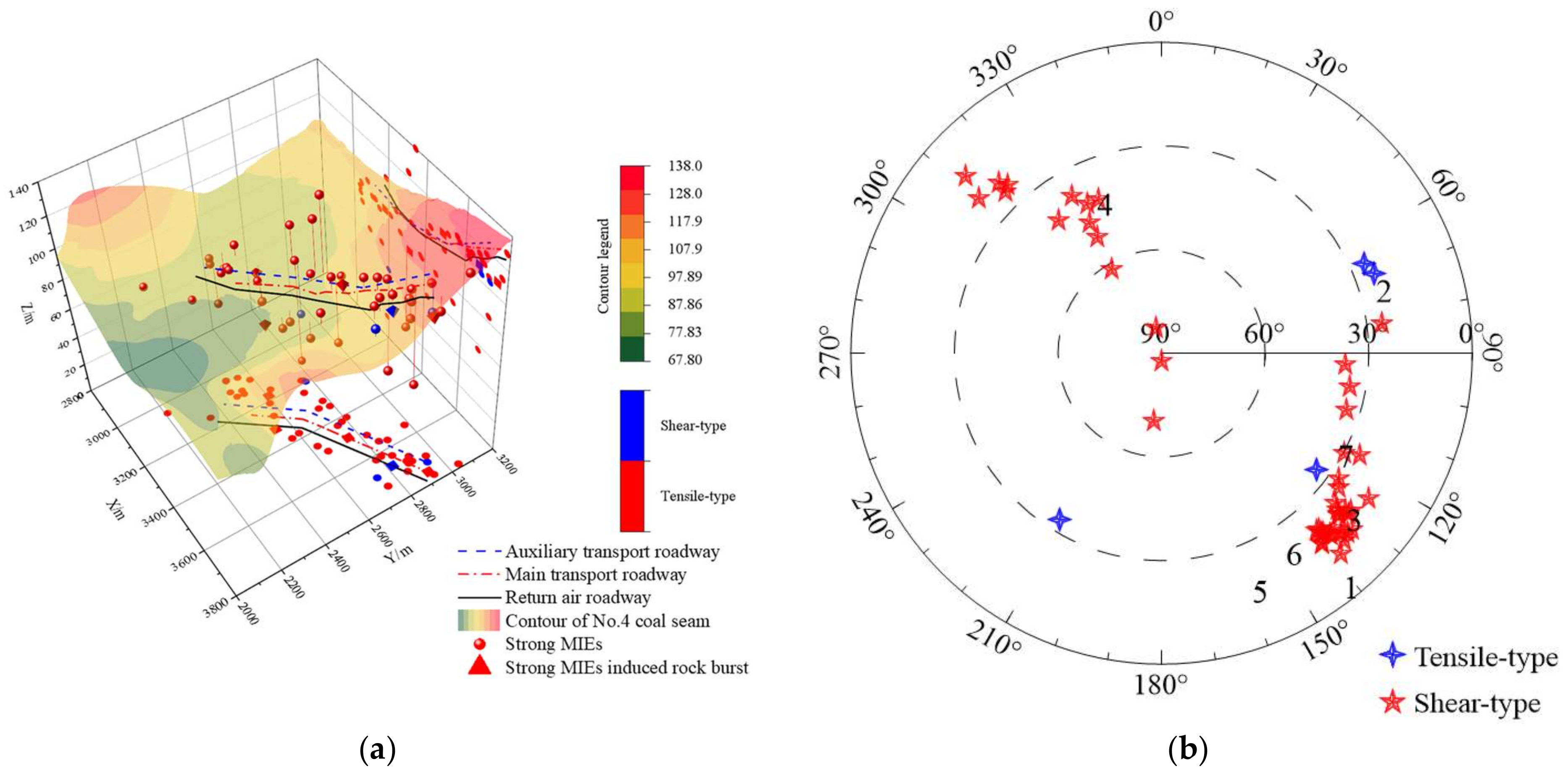
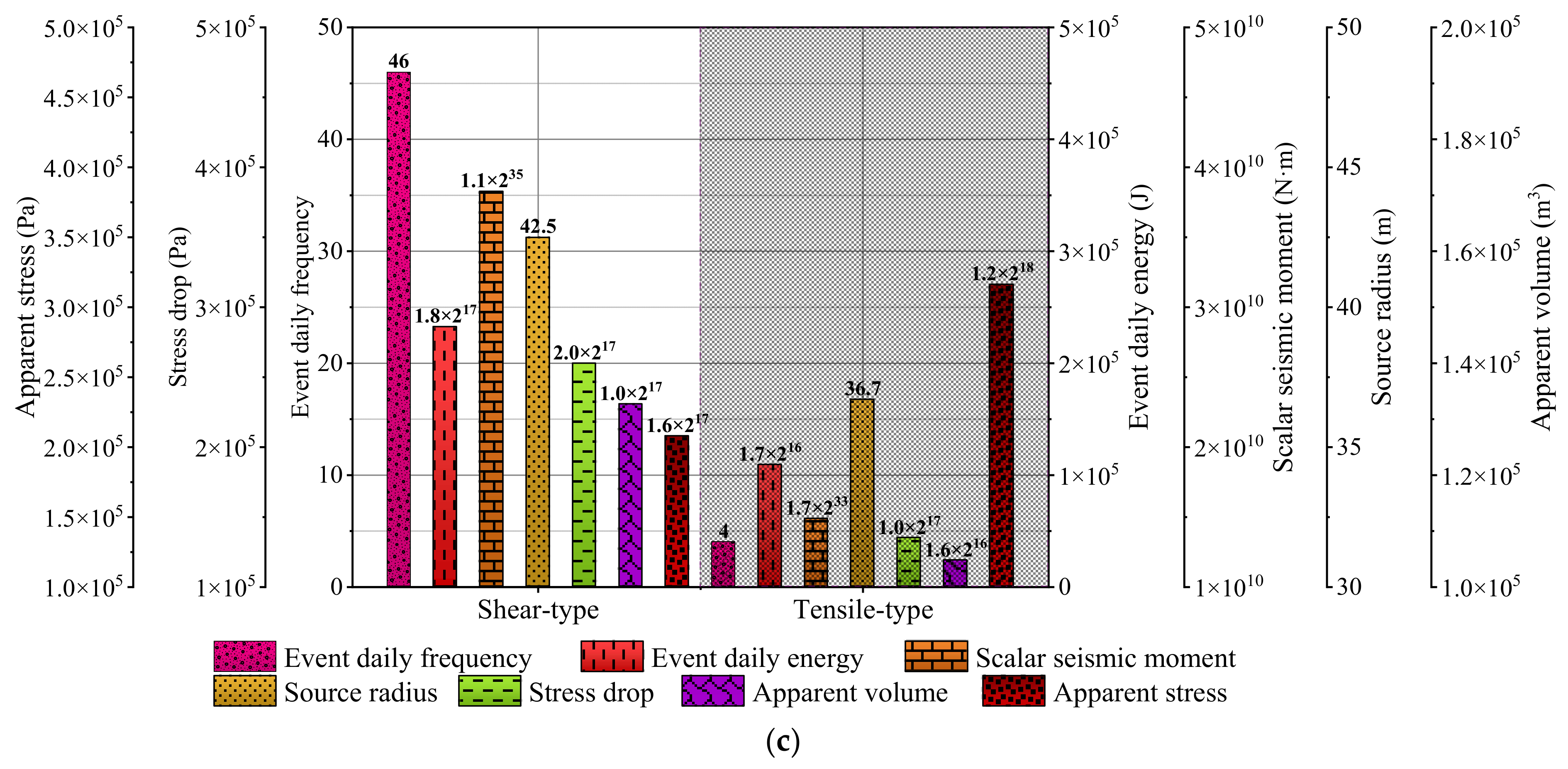
Publisher’s Note: MDPI stays neutral with regard to jurisdictional claims in published maps and institutional affiliations. |
© 2022 by the authors. Licensee MDPI, Basel, Switzerland. This article is an open access article distributed under the terms and conditions of the Creative Commons Attribution (CC BY) license (https://creativecommons.org/licenses/by/4.0/).
Share and Cite
Cao, A.; Liu, Y.; Chen, F.; Hao, Q.; Yang, X.; Wang, C.; Bai, X. Focal Mechanism and Source Parameters Analysis of Mining-Induced Earthquakes Based on Relative Moment Tensor Inversion. Int. J. Environ. Res. Public Health 2022, 19, 7352. https://doi.org/10.3390/ijerph19127352
Cao A, Liu Y, Chen F, Hao Q, Yang X, Wang C, Bai X. Focal Mechanism and Source Parameters Analysis of Mining-Induced Earthquakes Based on Relative Moment Tensor Inversion. International Journal of Environmental Research and Public Health. 2022; 19(12):7352. https://doi.org/10.3390/ijerph19127352
Chicago/Turabian StyleCao, Anye, Yaoqi Liu, Fan Chen, Qi Hao, Xu Yang, Changbin Wang, and Xianxi Bai. 2022. "Focal Mechanism and Source Parameters Analysis of Mining-Induced Earthquakes Based on Relative Moment Tensor Inversion" International Journal of Environmental Research and Public Health 19, no. 12: 7352. https://doi.org/10.3390/ijerph19127352
APA StyleCao, A., Liu, Y., Chen, F., Hao, Q., Yang, X., Wang, C., & Bai, X. (2022). Focal Mechanism and Source Parameters Analysis of Mining-Induced Earthquakes Based on Relative Moment Tensor Inversion. International Journal of Environmental Research and Public Health, 19(12), 7352. https://doi.org/10.3390/ijerph19127352







